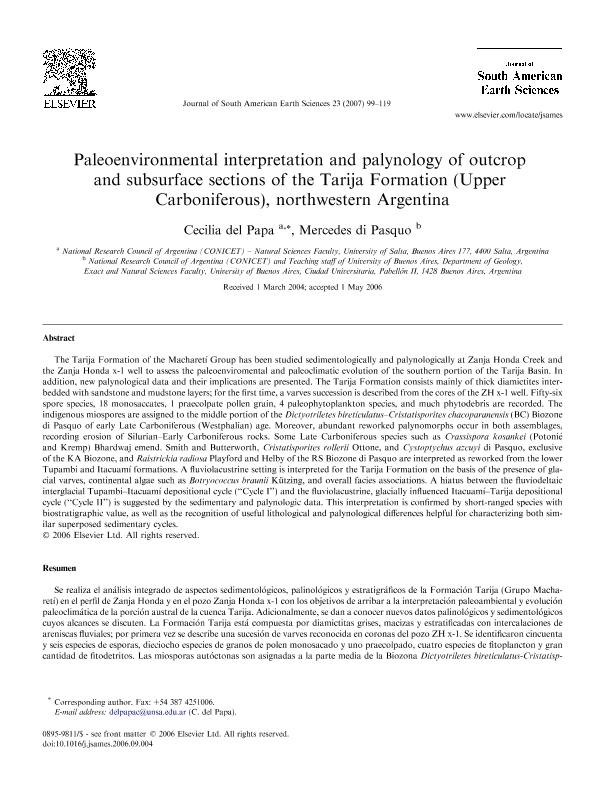Artículo
Paleoenvironmental interpretation and palynology of outcrop and subsurface sections of the Tarija Formation (Upper Carboniferous), northwestern Argentina
Fecha de publicación:
01/2007
Editorial:
Pergamon-Elsevier Science Ltd
Revista:
Journal of South American Earth Sciences
ISSN:
0895-9811
Idioma:
Inglés
Tipo de recurso:
Artículo publicado
Clasificación temática:
Resumen
The Tarija Formation of the Macharetí Group has been studied sedimentologically and palynologically at Zanja Honda Creek and the Zanja Honda x-1 well to assess the paleoenviromental and paleoclimatic evolution of the southern portion of the Tarija Basin. In addition, new palynological data and their implications are presented. The Tarija Formation consists mainly of thick diamictites interbedded with sandstone and mudstone layers; for the first time, a varves succession is described from the cores of the ZH x-1 well. Fifty-six spore species, 18 monosaccates, 1 praecolpate pollen grain, 4 paleophytoplankton species, and much phytodebris are recorded. The indigenous miospores are assigned to the middle portion of the Dictyotriletes bireticulatus-Cristatisporites chacoparanensis (BC) Biozone di Pasquo of early Late Carboniferous (Westphalian) age. Moreover, abundant reworked palynomorphs occur in both assemblages, recording erosion of Silurian-Early Carboniferous rocks. Some Late Carboniferous species such as Crassispora kosankei (Potonié and Kremp) Bhardwaj emend. Smith and Butterworth, Cristatisporites rollerii Ottone, and Cystoptychus azcuyi di Pasquo, exclusive of the KA Biozone, and Raistrickia radiosa Playford and Helby of the RS Biozone di Pasquo are interpreted as reworked from the lower Tupambi and Itacuamí formations. A fluviolacustrine setting is interpreted for the Tarija Formation on the basis of the presence of glacial varves, continental algae such as Botryococcus braunii Kützing, and overall facies associations. A hiatus between the fluviodeltaic interglacial Tupambi-Itacuamí depositional cycle ("Cycle I") and the fluviolacustrine, glacially influenced Itacuamí-Tarija depositional cycle ("Cycle II") is suggested by the sedimentary and palynologic data. This interpretation is confirmed by short-ranged species with biostratigraphic value, as well as the recognition of useful lithological and palynological differences helpful for characterizing both similar superposed sedimentary cycles.
Archivos asociados
Licencia
Identificadores
Colecciones
Articulos(CICYTTP)
Articulos de CENTRO DE INV.CIENT.Y TRANSFERENCIA TEC A LA PROD
Articulos de CENTRO DE INV.CIENT.Y TRANSFERENCIA TEC A LA PROD
Citación
del Papa, Cecilia Eugenia; Di Pasquo Lartigue, Maria; Paleoenvironmental interpretation and palynology of outcrop and subsurface sections of the Tarija Formation (Upper Carboniferous), northwestern Argentina; Pergamon-Elsevier Science Ltd; Journal of South American Earth Sciences; 23; 1; 1-2007; 99-119
Compartir
Altmétricas




